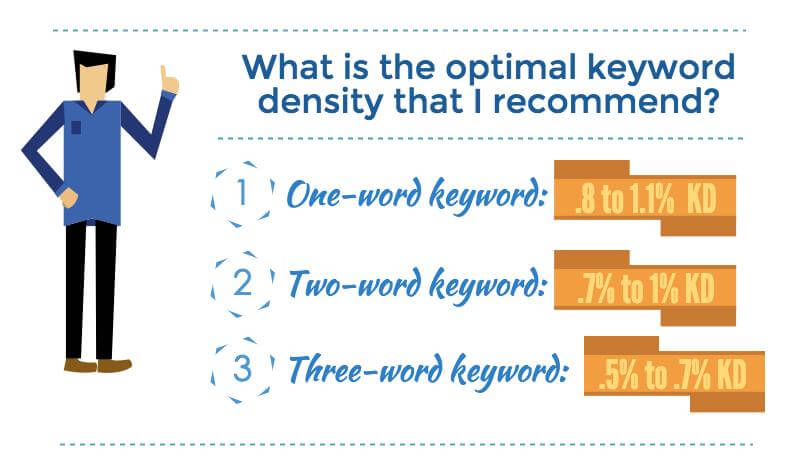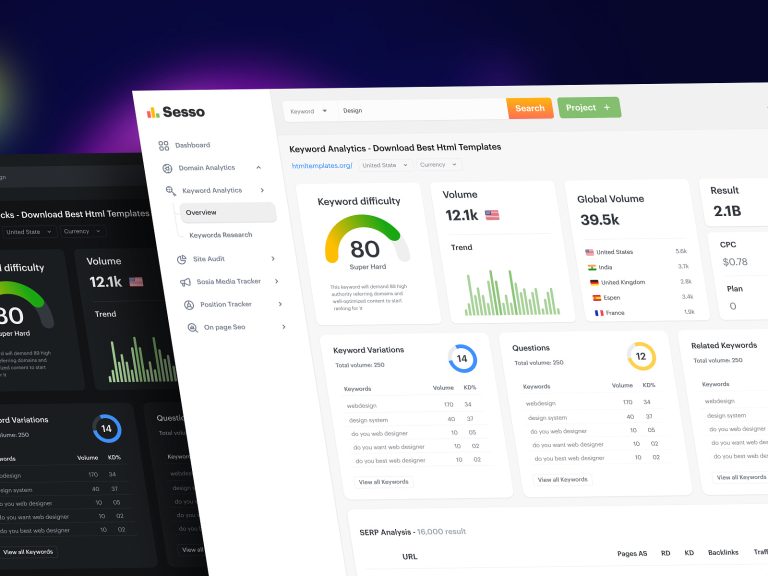
In the ever-evolving world of digital marketing, keyword density has long been a topic of discussion among SEO professionals. As one of the earliest SEO practices, it refers to the percentage of times a target keyword appears in relation to the total word count of a page. While its role has shifted over time, understanding and optimizing keyword density remains an essential part of any successful SEO strategy.
What is Keyword Density?
Keyword density is calculated as the percentage of times a specific keyword or phrase appears in your content compared to the total number of words on the page. This metric helps search engines understand the main topic of your content and how relevant it is to a particular search query.
The formula for calculating keyword density is:
Keyword Density (%) = (Number of keyword occurrences / Total word count) × 100
For example, if your keyword “digital marketing” appears 15 times in a 1,000-word article, your keyword density would be 1.5%.
What is the Ideal Keyword Density for SEO?

Most SEO experts recommend maintaining a keyword density between 1-2%. This range signals relevance to search engines without risking penalties associated with keyword stuffing. However, it’s important to note that there is no universal ideal keyword density. The optimal frequency depends on factors such as content length, search intent, and industry competition.
While some sources suggest a 1-2% range, others argue that this isn’t a hard rule. Google’s algorithms have evolved beyond simple keyword counts, focusing more on semantic relevance, user intent, and content quality. That said, maintaining a balanced approach ensures your content remains both search-engine-friendly and user-focused.
Is Keyword Density Still an Important Ranking Factor?
Although keyword density was once a primary ranking factor, modern search engines like Google now prioritize content quality, context, and user intent over raw keyword counts. Google’s semantic search capabilities allow it to understand the full meaning of your content, not just individual keyword matches.
However, keyword density still plays a role in signaling the main topic of your content to search engines. It helps them identify what your page is about and how relevant it is to specific queries. That said, overuse (keyword stuffing) can lead to penalties and harm readability.
Why Keyword Density Matters in SEO

Even though keyword density isn’t the most critical ranking factor today, it still matters for several reasons:
- Topical Relevance: Proper keyword density helps search engines determine what your page is about, supporting stronger alignment with search intent and ranking signals.
- Reduced Risk of Keyword Stuffing: Staying within the recommended 1–2% range minimizes the risk of over-optimization penalties that can harm rankings and credibility.
- Enhanced User Experience: Natural, well-integrated keywords make content easier to read, more engaging, and more likely to satisfy user queries.
- Stronger Semantic Coverage: Including related terms and keyword variations increases your chance of ranking for a broader set of queries and featured snippets.
- Support for Answer Engines and LLMs: Clear, topically aligned keyword usage improves extractability for AI-driven platforms like Google AI Overviews and ChatGPT, increasing citation opportunities and brand visibility.
Factors Affecting Optimal Keyword Density
While the general recommendation of 1-2% keyword density serves as a starting point, several factors influence the ideal keyword frequency for your content:
Content Length and Type
The length and type of your content play a significant role in determining optimal keyword density. Longer articles, such as in-depth guides or tutorials, naturally allow for more keyword repetition without sounding forced. In contrast, shorter pieces like product descriptions or news articles may require a more concise approach to keyword usage.
Similarly, the purpose of your content affects keyword density. Informational pages, which aim to educate readers on a topic, can often incorporate a higher number of keywords and related terms. Transactional pages, like product or service pages, may have a lower keyword density to prioritize persuasive copy and calls-to-action.
Search Intent and Relevance
Understanding the search intent behind your target keyword is key to optimizing keyword density. Consider the primary keyword you want to rank for, along with secondary and related keywords that help cover the topic comprehensively.
For example, if you’re targeting the keyword “how to bake a cake,” your content should include relevant terms like “cake recipe,” “baking ingredients,” and “cake decorating tips.” This helps search engines understand the context and depth of your content, improving its relevance to the target keyword.
Industry and Competition
The competitive landscape of your industry also impacts optimal keyword density. In highly competitive niches, you may need to use your target keyword more frequently to stand out and demonstrate relevance to search engines. However, it’s important to strike a balance and avoid over-optimization.
Established brands with strong domain authority may be able to rank well with lower keyword density, as search engines already recognize them as trusted sources. Newer or less authoritative sites may need to rely more on keyword optimization to improve their rankings.
Benefits of Maintaining Proper Keyword Density
Maintaining proper keyword density directly impacts both search visibility and user experience. Balanced keyword usage clarifies your page’s primary topic for search engines, making it easier for algorithms to understand and rank your content for relevant queries.
Key benefits include:
- Improved Topical Relevance: Proper keyword density helps search engines determine what your page is about, supporting stronger alignment with search intent and ranking signals.
- Reduced Risk of Keyword Stuffing: Staying within the recommended 1–2% range minimizes the risk of over-optimization penalties that can harm rankings and credibility.
- Enhanced User Experience: Natural, well-integrated keywords make content easier to read, more engaging, and more likely to satisfy user queries.
- Stronger Semantic Coverage: Including related terms and keyword variations increases your chance of ranking for a broader set of queries and featured snippets.
- Support for Answer Engines and LLMs: Clear, topically aligned keyword usage improves extractability for AI-driven platforms like Google AI Overviews and ChatGPT, increasing citation opportunities and brand visibility.
How to Optimize Keyword Density for SEO
Optimizing keyword density requires a strategic, user-first approach—not just counting keywords. Follow these steps to optimize and balance keyword density in your content:
- Perform Comprehensive Keyword Research
Start with in-depth keyword research to identify your primary target keyword and a set of semantically related terms (LSI keywords). Use tools like Google Keyword Planner, SEMrush, or Ahrefs to find high-value opportunities and variations.
Prioritize keywords that align with real user queries and business goals. Include both primary and secondary keywords to support semantic coverage.
- Map Keywords to Content Structure
Strategically place your main keyword and variations in high-impact locations for both users and search engines: - Title tag and H1: Ensure the core keyword appears in the page title and H1 heading.
- Subheadings (H2/H3): Use variations and related terms in subheads to improve semantic relevance.
- Introduction: Include your primary keyword within the first 100 words for topical clarity.
-
Meta description: Optimize for click-through and context, using the main keyword naturally.
-
Write Naturally and Prioritize Value
Integrate keywords in a way that supports clarity and provides value. Avoid forced repetition or unnatural phrasing. Focus on answering the user’s question comprehensively. Use synonyms, plurals, and contextually related phrases to broaden topic coverage. Review for readability—content should flow smoothly and remain engaging. -
Monitor and Audit Keyword Usage Regularly
Use SEO tools and analytics to review keyword density across your content portfolio. Identify pages with under- or over-optimization. Update outdated content and adjust keyword usage based on performance and user feedback. Track rankings, engagement, and visibility to inform future optimization. -
Leverage Automation and AI-Powered Tools
Automate keyword analysis and optimization using platforms like AirOps to scale best practices across your site. Automate audits for density, placement, and semantic coverage. Receive actionable recommendations to fine-tune content in real-time. Ensure consistency and reduce manual effort across large content libraries.
Keyword Density as a Part of a Modern SEO Strategy
Keyword density remains a relevant metric, but it is no longer the centerpiece of effective SEO. Modern search engines and answer engines prioritize context, semantic coverage, and user experience above simple keyword repetition. By focusing on natural keyword integration, strategic placement, and ongoing content audits, you can strengthen both your rankings and your content’s readability.
The most successful SEO strategies now blend research-driven keyword usage with comprehensive, value-driven content that meets the full intent of your audience.
How AirOps Helps You Optimize Keyword Density and SEO Performance
AirOps empowers marketing and content teams to optimize keyword density and overall SEO with AI-powered workflows, automated keyword analysis, and actionable insights. AirOps is built to help teams:
- Monitor and optimize keyword density at scale
- Identify and implement related terms and semantic variations
- Automate regular content audits for ongoing SEO health
- Align your content with both search engine and answer engine best practices
Book a strategy session to see how AirOps can help you scale smarter, stay ahead of SEO changes, and future-proof your content for both traditional search and the new era of answer engines.
Final Thoughts
In conclusion, while keyword density is no longer the sole determinant of SEO success, it remains an important component of a well-rounded strategy. By understanding the nuances of keyword density, balancing it with other SEO factors, and focusing on delivering value to users, you can create content that ranks well and resonates with your audience.
Remember, the goal of SEO is not just to appease search engines but to provide meaningful, high-quality content that addresses the needs of your users. With the right approach, keyword density can be a powerful tool in achieving that goal.






